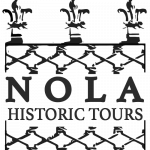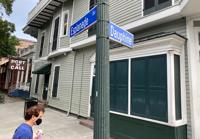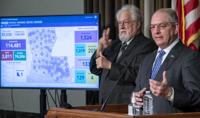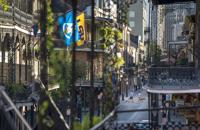from NOLA.com
Bourbon Street’s history can explain its appeal to visitors despite coronavirus restrictions
Maybe it’s the pavement.
Bourbon Street’s appeal to visitors can be explained by a number of factors, most of them revolving around alcoholic drinks and music bars.
But even on the gray and uneventful Saturday following Mayor LaToya Cantrell’s July 24 announcement banning to-go drinks — and two weeks after Gov. John Bel Edwards had ordered all bars closed — pedestrians still gravitated to the famous strip.
How many? Using live images from the EarthCam camera mounted on the Cat’s Meow, I estimated about 6 to 7 pedestrians per minute passing through the Bourbon and St. Peter intersection in the late morning of Thursday, July 23, the day before Mayor Cantrell’s announcement. By late afternoon, that figure picked up 10 per minute, and by 9 p.m. it hovered around 25 pedestrians per minute. Most had go-cups in hand.
On Saturday, July 25, the first day of the ban, the morning pace was about the same as Thursday’s. But by afternoon, it had picked up to 17 to 20 people per minute, and steadily increased over the next eight hours, peaking between 10 and 10:30 p.m. to around 58 people per minute. Few appeared to be holding drinks, and those who did had probably purchased cans or bottles at stores. All the bars and music clubs were closed.
Restaurants, trinket shops, historic sites and beautiful architecture can be found elsewhere in the Quarter. Why parade up and down this particular strip of asphalt, if it had been stripped of its purported appeal?
The answer traces to an adaptation made in the late 1960s, which itself derived from circumstances dating to just after the Civil War.
Just another downtown street
For its first century and a half, Bourbon Street was just another French Quarter street. Its demographics were mixed in terms of race and class, and its predominant culture was French Creole. Businesses varied; records from the 1700s and early 1800s indicate no particular cluster of one type of enterprise or another that would have set Bourbon apart.
Later in the antebellum era, Bourbon Street did become home to some prominent venues that generated nighttime foot traffic, in particular the French Opera House, which opened in 1859 on the corner of Toulouse. But other streets had equivalent attractions.
Antebellum Bourbon Street was no fancier or rowdier than other downtown streets, and neither famous nor infamous. There was certainly no nightly pedestrian parade.
Things started to change after the Civil War, when the French Quarter declined economically, and business owners explored new ways of making money.
Among them was the “concert saloon,” an innovation in nocturnal entertainment also seen in other port cities, in which attractive young women (“beer jerkers”) served alcohol to an exclusively male clientele enjoying cabaret-style entertainment, such as can-can dancing and rollicking piano.
In 1868, Henry Wenger opened a concert saloon on the 100 block of Bourbon, and it soon became popular. “Wenger runs four girls as ‘jerkers,’ wrote the New Orleans Republican in 1869, and “makes Bourbon street musical… Music fills the establishment, and good music at that.”
Others wanted in on the fad, and more concert saloons opened nearby. Gambling joints and brothels followed. By the late 1800s, the upper French Quarter had developed quite a night scene, including rampant prostitution, and Bourbon Street ran through the middle of it.
To curtail the iniquity, the city in 1898 prohibited the sex trade everywhere except some 16 blocks behind Basin Street, which had been a vice area since the 1840s. Prostitutes sardonically dubbed the district “Storyville,” to deride Councilman Sidney Story, who had spearheaded the effort.
For the next two decades, Storyville became famously infamous.
When the Navy ordered Storyville closed in 1917 as troops set sail for the Great War in Europe, the action shifted to nearby North Rampart Street, an area nicknamed the “Tango Belt.” When police raided the Tango Belt in the 1920s, the action increasingly shifted to Bourbon Street, which had been honing yet another innovation in the nocturnal entertainment scene: the nightclub.
Unlike concert saloons, which were boisterous and unsavory, nightclubs, with their roots in Paris’ Belle Époque, catered to respectability. Featuring fancy dinners for couples, with classy entertainment and an air of exclusivity, nightclubs (or “supper clubs”) reflected the changes of the 1920s, including social acceptance of women in places that served alcohol.
Live jazz fit into the nightclub scene perfectly — we call it the Jazz Age for a reason — and Bourbon Street became home to a number of these venues, starting with “Count” Arnaud Cazenave’s Maxime Supper Club at 300 Bourbon. They operated door-to-door with a growing number of restaurants and bars, which found creative ways to circumvent Prohibition. By the 1930s, Bourbon Street had become renowned, at least locally.
Becoming famous, and infamous
When World War II broke out, thousands of troops and plant workers found the escapism they craved on Bourbon Street, and its bars and clubs flourished. Patrons took home stories of their delectable time in New Orleans, acting as pro bono marketing agents for Bourbon Street.
Tourism increased; the nightclub scene grew into a glitzy line of burlesque clubs; and Bourbon Street became nationally famous.
Importantly, all the action in this era was indoors. There were no street closures, no crowds in the public space, and certainly no go-cups. Only hobos drank in the open.
Instead, there were closed doors manned by uniformed doormen, as if to underline the difference between the public street and exclusive indoor space. The whole point of going to Bourbon Street in this era was to see and be seen in swanky clubs, dressed to the nines, partaking of libations and epicurean delights while enjoying live music and suggestive entertainment.
Bourbon Street was also strictly segregated racially. African Americans could only work there, and if playing music on stage with white burlesque acts, the musicians were sectioned off with a half-pulled velvet curtain.
Many clubs subsidized their extravagant floor shows and bands or orchestras with the same sort of illicit gambling activity rampant in the upper French Quarter in the late 1800s, including keno, craps, cards, bingo, dice, roulette, lottery and horse betting, and now including slot machines and payoff pinball. Another lucrative scam was “B-drinking,” in which marks were conned into buying expensive drinks by flirtatious women working for the house.
Some swindles ended in violence, and beneath the glamour, Bourbon Street developed a sordid reputation.
In the early 1960s, “cleaning up Bourbon Street” became a political priority, and newly elected district attorney Jim Garrison organized a series of police raids to crack down on the rambunctious strip.
The raids worked almost too well. Having lost their illicit subsidies, many Bourbon Street clubs closed permanently. Commercial real estate dropped in value, and tawdry dives opened in their stead. Times were changing, too; the glitz of burlesque had dimmed, and young people came to view Bourbon’s nightclubs as unctuous and square.
By the late 1960s, Bourbon Street had gone from gaudy to déclassé, and merchants struggled to attract moneyed patrons among the growing numbers of young hippies.
Taking it to the street
In 1967, one bar owner devised a clever idea. If people were unwilling to come inside, why not sell drinks to them outside, through windows and doorways? “Window hawking” of beer and other drinks, as well as hot dogs, corndogs, and snacks, became a low-overhead, high-gross way of supplementing the income of bars and eateries.
In this same era, three major hotels opened directly on Bourbon Street, putting many more warm bodies on the pavement nightly — so much so that in 1971, the city began blocking vehicular traffic at dusk.
People loved the freedom of walking about, beer bottles in hand. Broken glass became a problem, and the city responded by banning window hawking. But the ordinance was erratically enforced, and a judge ruled it unconstitutional in 1981, opening the door to more to-go vendors, who by now had switched to paper or plastic “go-cups.”
Bourbon Street adapted to changing times by shifting its appeal — and its commerce — from private indoor space to outdoor public space.
The nightly pedestrian parade was born. Drinking became ambulatory, spectators became the spectacle, the pavement became a stage, and the historic buildings something of a prop.
Stores, music clubs, and eateries became supply stations and rest stops, rather than destinations. Many enterprises threw open their doors and removed table seating in an attempt to conflate outdoor and indoor space.
It was a winning formula, and the numbers prove it. While researching a book on the history of Bourbon Street some time ago, I measured crowd size weekly throughout 2011 to understand how it works.
The structure of the daily pattern was essentially the same as described earlier, starting low in the morning, rising steadily in the afternoon and evening, peaking in mid-to-late evening, and precipitously dropping off after midnight.
Of course, the absolute numbers were much higher in normal times, as was tourism generally. My counts in 2011 were more than double the highest figures seen during COVID-19. But the shape of the daily curve remains the same.
Likewise, how people spatially distribute themselves along Bourbon Street has also persisted. In normal times, the number of pedestrians starts modestly in the 100 block, rises on the 200 block, and peaks on the 300-400 blocks, between Bienville and St. Louis streets.
On a typical weeknight, the crowd moves here at about 45 people per minute; on Friday and Saturday nights, it more than doubles to around 105 per minute, and on Mardi Gras it doubles again.
Foot traffic remains high until after the St. Ann intersection (the 800 block), when it diminishes to one last hurrah at Lafitte’s Blacksmith Shop at the corner of St. Philip. In its remaining residential blocks, Bourbon, like 200 years ago, becomes just another Quarter street.
The sheer momentum and social appeal of the half-century-old nightly pedestrian parade, which in many people’s minds is Bourbon Street, explains why it is still rolling today, even when drained of its inebriating fuel and silenced of its pulsating soundtrack.
Bourbon Street has proven adept at cleverly converting public space into commercial space, just as it had succeeded in monetizing nightclubs in the early 1900s and concert saloons in the late 1800s.
At a time when restaurants are experimenting with moving tables to sidewalks, and the city considers closing French Quarter streets to make room of outdoor commerce, Bourbon Street has had decades of practice in taking its business to the street—even when they’re no business to take there.







